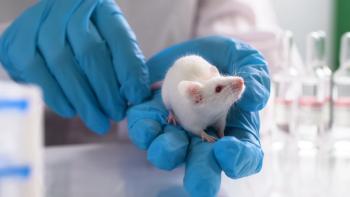
- dvm360 November 2023
- Volume 54
- Issue 11
- Pages: 52
Where did AI come from and how can we use it in vet med?

The history of artificial intelligence, where we’re at today, future applications, and leveraging this tool to advance patient outcomes were discussed at Fetch Coastal
Artificial intelligence (AI). It’s everywhere and being used every day, even if you don’t realize it. It’s what’s powering self-driving cars, determining the recommended TikTok videos appearing on your feed—it’s no coincidence those cute cats keep coming up— and it’s the chatbot kindly helping you make a return on Amazon’s website.
To address this emerging tool, Rick Albrecht, MSEd, talent acquisition manager for the United States Veterinary Talent Association in New York, New York, provided an in-depth look at AI, in a lecture1 at the Fetch Coastal conference in Atlantic City, New Jersey. He discussed its history, how it’s made advances to get to where it is today, AI applications in veterinary medicine, and what the future holds.
What is AI?
As was fitting for his lecture, Albrecht used an AI tool—Google Bard—to ask AI what AI is. The answer: artificial intelligence is the branch of computer science dealing with the creation of intelligent agents, it can reason, it can learn, and it can act autonomously. Albrecht further explained that AI acquires data and processes it by labeling, organizing, and categorizing it. Based on this data, it spots trends, provides information, and draws conclusions on the next steps. He added, “These technologies will have the ability to solve a wide range of problems, from gameplay to medical diagnoses, which is what we can use in veterinary medicine,” he said.
AI accomplishes this through algorithms, which Albrecht shared are “basically a set of well-defined instructions on how to solve a problem.” Algorithms are used in your daily life, from going through the process of dressing yourself to figuring out what to eat for lunch. In the computer world, there are 7 types of algorithms to solve problems, including brute force, greedy, recursive, backtracking, dynamic, randomized, and divide and conquer.1
A brief history of AI
Though AI seems to be emerging in recent years, the concept was initially proposed in 1950 by Alan Turing that machines could have the potential to think.2 Fast forward several decades to its early applications, and AI was primarily used for gameplay (eg, Space Invaders in 1978, Pac-Man in 1980),3 and was incredibly simplified. Albrecht explained this first stage of AI development was reactive. “You put rules into a computer, and based upon what rules you put in there, it knew what to do. Unlike machines now, it didn't learn. It would just react to what it saw, it didn’t make predictions and things like, ‘Oh, this person is using this strategy, so I know what his next move is going to be.” He added, “It just reacted to what it saw in front of it, and it reacted the same way every time. It didn't learn, it didn't grow, it didn't get better as it went.”
Where we’re at now with AI
Currently, AI is in its limited memory stage. According to Albrecht, this allows humans to train computers with new data to improve over time and was developed in 2012 in tandem with the deep learning revolution.4 Albrecht further explained that limited memory AI “can complete complex classification tasks, meaning you give it a bunch of information, it can tell you what things have similarities and differences. [It uses] historical data to make predictions. It informs reference models for solving future problems, so we know [based on] what has happened in the past, what it is going to look like in the future.”
The machines learn through supervised or unsupervised learning. Albrecht said that supervised learning consists of human involvement and training computers to identify information so they can classify and organize data (eg, facial recognition on your smartphone). Meanwhile, unsupervised learning involves providing the computer information and asking it, “What can you tell me about it? What trends do you see? What patterns relate to each other in any way?” exemplified Albrecht. Particularly for veterinary medicine a type of unsupervised learning for computers that is invaluable is predictive analysis. “It uses current and historical data to make predictions. It helps us optimize processes, identify potential risks, and guide decisions for better patient outcomes,” he said.
Leveraging AI in veterinary medicine
A major advantage of AI to veterinary medicine is it can help drive proactive rather than reactive care. “If we can use this technology to avoid future problems and prevent them from happening, it's going to be much easier on us, it's going to be much easier on pets, and pet owners,” Albrecht shared.
Some AI tools can help analyze pets’ genetic data, then reveal prerequisites for disease and suggest preventive treatments. AI can also be used to choose the best treatment option based on each unique patient and predict the success rates of each treatment. “Let's say, ‘Oh, yeah, this medication works great. But does it work great in this type of dog with this signalment with this disease and this lab work or is there a better medication?’” said Albrecht.
AI can perform anomaly detection as well, meaning it can identify data points within normal limits and those that are outside of normal limits. “Let's say you have a large dataset of animal lab work, it can identify what's normal and then it'll look at what's abnormal. And now with the abnormal group, what is similar about all of them? Why are they abnormal? What's going on with these guys that puts them outside of normal?” Albrecht added.
On a wider scale from a One Health approach, AI can be used to predict outbreaks and epidemics. “What conditions are right or wrong for an outbreak to happen? Now, if this outbreak is going to happen, can we create a model for what it's going to look like? If we have that model, how can we avoid it happening? How can we slow it down? How can we best treat it?” Albrecht explained to attendees.
What the future holds
“We're still early on with what [AI] can do, it's taken us 80 years to get where we're at right now. But, the explosion, the growth over the next 5 [to] 10 years is going to be amazing,” said Albrecht.
Currently, AI has narrow intelligence which means it can only perform a certain set of actions based on its programming.1 “These types of programs are very narrow in what their focus is,” Albrecht continued. “You can't just go to any AI program and ask it to do whatever. They're very specific in what they do.”
The next phase of AI will consist of the theory of mind, which is when computers understand that humans have thoughts, emotions, beliefs, and needs and adapt to those.5 From there, AI will become aware of its existence. “It will have the intellectual and emotional capability of a human. It can think, it can desire, it can understand its feelings,” said Albrecht.
Albrecht noted that it will be fascinating to see the applications of future AI in veterinary medicine and like any technology, with the good, comes bad. If it is helping improve patient outcomes, though, we can only hope the positives outweigh any negatives. “This is something that is not going anywhere,” said Albrecht. “This is the next phase of our society’s technology.”
References
- Albrecht R. AI and the future of the veterinary practice. Presented at: Fetch dvm360® conference; Atlantic City New Jersey. October 9-11, 2023.
- Turing AM. I—Computing machinery and intelligence. Mind. 1950;LIX(236):433-460. doi: 10.1093/mind/LIX.236.433
- History of AI use in videogame design. Big Data Analytics News. March 24, 2021. Accessed October 13, 2023. https://bigdataanalyticsnews.com/history-of-artificial-intelligence-in-video-games
- Marr B. What are the four types of AI? Accessed October 13, 2023. https://bernardmarr.com/understanding-the-4-types-of-artificial-intelligence
- Davies A. What is theory of mind AI? DevTeam Space. Accessed October 13, 2023. https://www.devteam.space/blog/theory-of-mind-ai
Articles in this issue
almost 2 years ago
Shocked? Extracorporeal shockwave therapy offers many benefitsabout 2 years ago
Holiday gift ideas for pets and professionalsabout 2 years ago
Enrichment never gets old: Why senior pets need stimulation tooabout 2 years ago
How to leverage allyship to create more inclusive culturesabout 2 years ago
Is your practice seeing enough senior pets?about 2 years ago
The spectrum of care with Emily M. Tincher, DVMabout 2 years ago
Hire attitude and gratitude...train aptitude!about 2 years ago
Nonpharmacologic management of canine osteoarthritis: Part 1Newsletter
From exam room tips to practice management insights, get trusted veterinary news delivered straight to your inbox—subscribe to dvm360.






